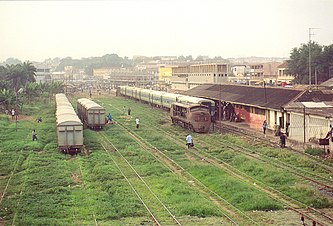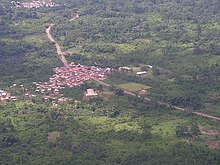Transportation in Ghana
In a developing country like Ghana in particular , the transport sector plays a key role in shaping the overall economic process as well as in terms of the possibilities for realizing future economic developments. The fact that Ghana's infrastructure, on which traffic is based, is relatively poorly developed, as everywhere in tropical Africa, is primarily due to the much higher cost intensity of road and track construction in tropical Africa due to technical difficulties compared to Europe and elsewhere with it.
railroad
|
year |
transported | People km |
Freight km |
|
|---|---|---|---|---|
| people | freight | |||
| [1000] | [1000 t] | [Million km] | ||
| 1971 | 7,441.4 | 1,592.3 | 447.9 | 292.7 |
| 1973 | 7,897.6 | 1,389.7 | 500.9 | 292.7 |
| 1988 | 3,259.4 | 774.0 | 389.3 | 125.5 |
| 1989 | 2,890.4 | 751.4 | 330.5 | 130.8 |
| 1990 | 1,896.8 | 724.1 | 277.5 | 126.9 |
| 1996 | 2,100 | 857 | 208 | 152.8 |
| 2001 | 600 | 1,500 | 62 | 220 |
Today's rail network in Ghana measures around 1,300 km. The main routes connect Takoradi - Sekondi - Tarkwa - Kumasi (174 km) and Accra - Kumasi (309 km). The first line is mainly used to transport manganese and gold ores to the shipping port in Takoradi. Ghana's rail network has Cape Gauge , i. H. the tracks are 1.067 m apart.
Although export goods such as For example, cocoa or wood traditionally represent the largest proportion of freight transported by rail, but their transport has increasingly shifted to the road since the late 1970s. The reason for this was the increasingly deteriorating condition of the railway systems. Since 1976, the railway company has felt compelled to request regular subsidies from the state for the maintenance of its facilities. In 1996, the government made available USD 150 million for the expansion of the routes in the west to connect further mining areas with the port of Takoradi.
In 1995 the Ghanaian railway company got three new locomotives and 60 new wagons, which had been financed by the German Reconstruction Loan Corporation and the Japanese Overseas Economic Co-operation Fund .
At the end of 2004, OPEC granted Ghana a loan of USD 5 million for the further expansion of the rail link between Accra and the port of Tema and to the oil refinery in Tema.
Major companies
- Ghana Railways Corporation (GRC),
- founded in 1901 as a company for the operation and maintenance of the railway lines; formerly state; privatized since April 2004
Road traffic
In 1996 Ghana's road network was estimated to have a total length of 37,800 km. Of these, 30 km are motorway ( motorway ), 5,230 km are main roads and 9,620 km are secondary roads . 24.1% of the streets have a solid bitumen or concrete surface. The main connections form roughly a triangle Takoradi - Kumasi - Accra-Tema. Ghana's road network is described as relatively good in relation to the standard in tropical Africa, but its maintenance is a permanent problem in Ghana. Spare parts for road vehicles are a rarity, especially since their distribution system has steadily deteriorated since the early 1960s.
|
year |
approved | |
|---|---|---|
|
Passenger |
Trucks |
|
|
[1000] |
||
| 1974 | 55.0 | 43.9 |
| 1988 | 51.6 | 25.2 |
| 1994 | 90.0 | 44.7 |
| 1998 | 301 | 44 |
| 2000 | 397 | 53 |
| 2002 | 463 | 56 |
In 1995 the Ghanaian government began a five-year road expansion program for which USD 259 million was made available. In 1996 four new road connections were completed, 87 km of gravel and 213 km of surface renewal. Government expenditures for road construction were expected to be 603.5 billion cedis in 1999, and 832.7 billion cedis in 2000 and 863.7 billion cedis in 2001. When he presented his budget in 1999, the Minister of Finance announced the introduction of a road user fee, which is to be levied on reconstructed and renovated road sections and bridges. The routes Tema - Akosombo, Tema - Aflao, Yamoransa - Takoradi, Yamoransa - Anwiankwanta, Accra - Yamoransa, Accra - Kumasi, Kumasi - Dunkwa and Kumasi - Kintampo are intended as roads with toll status. The construction of a new road link Mallam - Kasoa and Kasoa - Winneba began in 2003.
In 2003 a project financed by the Japanese government was started, which provides for the construction of 36 bridges across the country.
Major companies
- Ghana Highway Authority
- Founded in 1974 as a company for the planning, development and administration of the most important connecting roads and associated traffic structures
- Vanef STC
- founded in 1995; formerly State Transport Company ; has been privatized since 2000; operates national and international passenger transport
Shipping
|
year |
||
|---|---|---|
|
Number of |
Total |
|
|
[1,000 GRT] |
||
| 1996 | 195 | 134.7 |
| 2002 | 213 | 126.2 |
| 2003 | 207 | 121.3 |
| 2004 | 210 | 116.7 |
Ghana has two deep-water ports: the port of Takoradi , which was expanded in the 1920s, and the port of Tema (near Accra), which opened in 1961 . Both are connected to Kumasi by rail. A renovation of the two ports, which cost an estimated US $ 100 million, was completed in 1990. In 1996, the Ghana Ports and Harbors Authority started again with an expansion program for the two ports. A $ 365 million project to provide better access to both ports started in 1998.
In 1996, 6.7 million tons of goods were shipped via both ports.
Although the Volta Reservoir created an area of water in the 1960s that extends 400 km inland from the Akosombo Dam and has since opened up new opportunities for small transports from inland, the movement of goods on the Volta and the Volta Reservoir is relatively modest today hardly any significant extent.
Major companies
- Ghana Ports and Habour Authority
- Holding company to operate the ports of Takoradi and Tema
- Alpha (West Africa) Line Ltd.
- The shipping company sees its focus on freight traffic to West Africa, the USA, the Far East and Northern Europe.
- Black Star Line Ltd.
- previously state company; was however in the process of privatization at the end of 2004; operates both passenger and cargo shipping to Great Britain, Canada, the USA, the Mediterranean states and other states in West Africa
- Liner Agencies and Trading (Ghana) Ltd.
- international freight service
- Maersk Sealand Ghana
- founded in 2001 as a Ghanaian branch of the Danish company Maersk
- Scanship (Ghana) Ltd.
- Grimaldi Ghana Ltd.
- Ghanaian branch of the Italian liner shipping company GRIMALDI GROUP in Tema, which offers sea transport for all types of cargo (Ro / Ro, conventional, container) on its own multipurpose ConRo ships from / to Europe, the USA, West Africa and Brazil.
Others
- Ghana Shippers' Council
- The organization was founded in 1974 as an interest group of currently approx. 28,000 (2004) registered sailors. It also mediates cargo handling and other related services.
Civil aviation
|
year |
|
transported |
Passenger km |
Air freight km |
|---|---|---|---|---|
| [Million km] | [1000] | [Million km] | ||
| 1974 | 3.6 | 136 | 151 | 16 |
| 1989 | 4th | 232 | 382 | 48 |
| 1990 | 4th | 188 | 366 | 49 |
| 1991 | 5 | 192 | 331 | 58 |
| 1994 | 5 | 182 | 478 | 72 |
| 1995 | 5 | 186 | 611 | 86 |
| 1996 | 6th | 197 | 655 | 91 |
| 1999 | 9 | 304 | 1,097 | 151 |
| 2000 | 9 | 314 | 1,204 | 162 |
| 2001 | 18th | 301 | 1,233 | 157 |
Ghana's current main airport is Accra-Kotoka . There are also airfields in Kumasi , Navrongo , Sunyani , Takoradi , Tamale , Yendi and Wa . A special air freight terminal at Kokoka Airport was completed in 1994. In 2001, Kotoka Airport handled 622,525 passengers and handled 44,779 tons of air cargo.
Major companies
- Ghana Civil Aviation Authority (GCAA)
- Afra Airlines Ltd.
- started flying in mid-2005
- since 2003
- Gemini Airlines Ltd. (Aero Gem Cargo)
- currently (2005) weekly cargo flights between Accra and London
- founded in 2005 as a new national airline; Joint venture between the state of Ghana and GIA-USA
Special features in traffic engineering
In tropical Africa, water is the biggest problem with both roads and railways. The heavy torrential rain, which comes down very quickly in the rainy seasons, can trigger stratified floods, which often lead to rain damage to the roads and railway embankments. This is especially the case when the drainage of the water masses, for whatever reasons, cannot be carried out correctly, e.g. B. if passages in the dams are blocked or incorrectly set. Particularly in areas where humans have made a significant contribution to soil erosion through deforestation and turf destruction, stratified floods tear channels in the ground, which also continue in and under the road and track structure and cause tears. To counter this, the road type known as "Donga" was developed especially for tropical Africa during colonial times. In the case of the Dongas, the body of the road, which was provided with a solid ceiling, was lowered so that the road also acts as a water drainage channel during the rainy season. During this time it is not passable. This has also been implemented in bridge construction, where one spoke of diving bridges (English low-level bridges ) and low bridges (English semi-level bridges ). The latter remain passable in the case of "smaller" rain. In the past, high bridges were avoided for reasons of cost or, if so, then mostly only built for railways. When planning the traffic structures, it was assumed that the water level of the West African rivers can rise up to 10 m after heavy rain and that it can take up to weeks before flooded traffic routes can be used again.
Footnotes
- ↑ The maximum speed on the Cape Lane is 88 km / h, the average is 60 km / h.
- ↑ a b The information relates to the inventory on December 31 of the respective year.
swell
- Africa South of the Sahara (London) : 8 (1978/79) 417f .; 24 (1995) 445; 30 (2001) 561f .; 35 (2006) 533f.
- Karl Krüger, Africa , Berlin 1952



